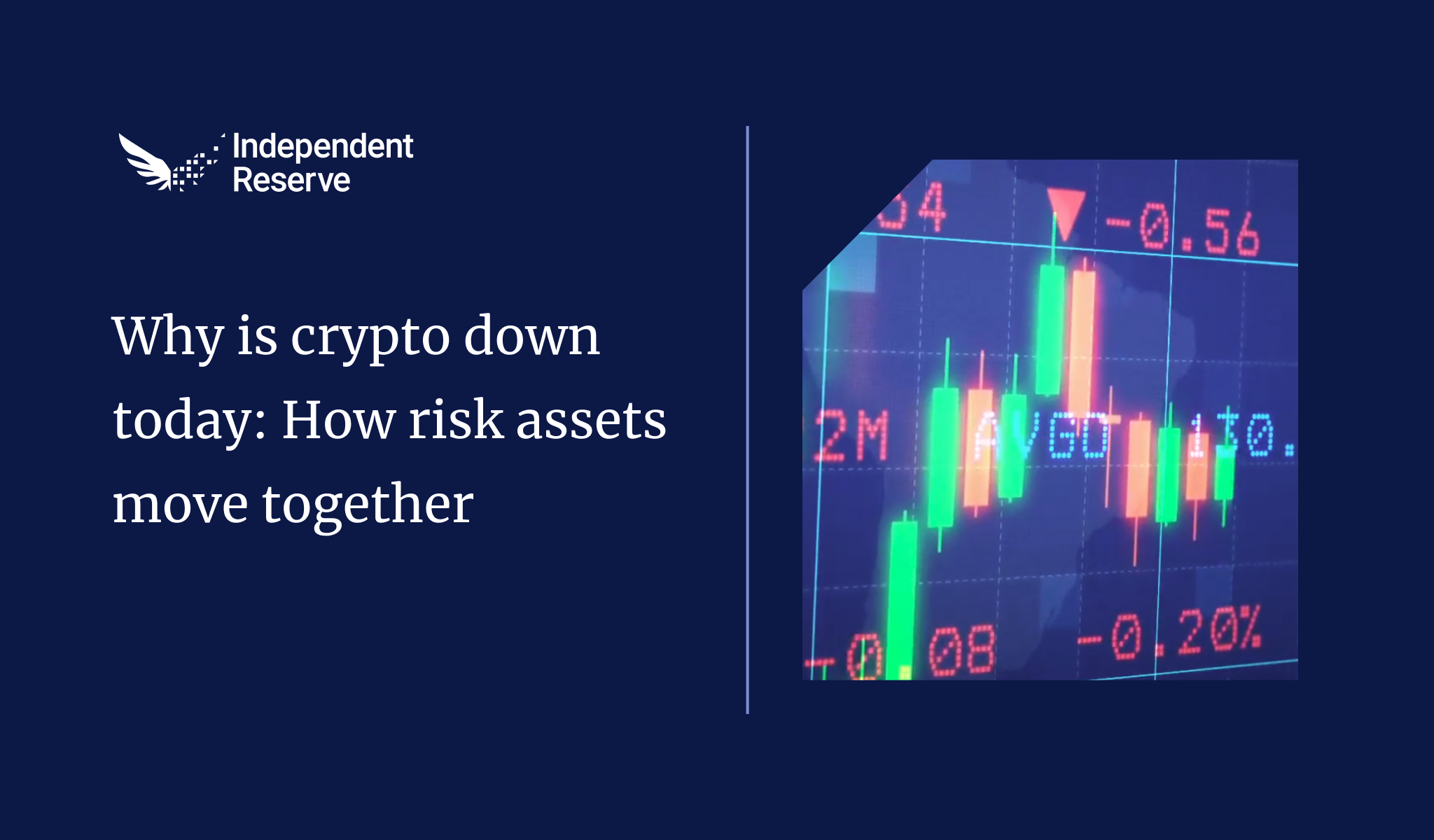In markets
Is Crypto Winter over? Bitcoin suddenly broke through US$20K (A$28.7K) on Saturday and then US$21K (A$30.2K) on Sunday. Bears were rekt with US$500 million (A$718M) in liquidations. Bitcoin is again trading above the 2017 top and has recovered its losses from the FTX collapse. Pundits point to inflation moderating by 0.1% in December, FTX finding US$5B (A$7.18B) in assets, whales growing more confident and the Bitcoin halving in May 2024 as possible reasons for the rally. Bitcoin is currently trading at A$30,430 (US$21.2K), up 19% for the week, while Ethereum is at A$2,265 (US$1,577), up 15% on seven days ago. Everything else increased: XRP (7%), MATIC (17%) and SOL (39%). The overall crypto market cap is at $1.425 trillion (US$992B). After 10 months the Crypto Fear and Greed Index hit 52 or ‘neutral’ two days ago; it currently sits around the same at 51 at the time of writing.

From the IR OTC Desk
The US December inflation data has confirmed that inflation has peaked. Last Thursday, the ‘headline’ US inflation rate printed at 6.5% (YoY) versus 7.1% in November. The core inflation rate also lowered to 5.7% in December from 6% in November. While the absolute value of the inflation rate remains optically elevated, the 3-month annualised rate of core inflation is now 3.1%. Last week we highlighted the reduction in US wage inflation documented in the December job series – which surprised in its move lower to 4.6%. The change in inflation data has been the most significant driver of risk assets and cryptocurrencies.
Some additional detail:
Risk asset pricing appears to be profiling the relative ‘stickiness’ of inflation. It is well known that volatile items in the inflation basket can skew headline inflation relative to the core reading. Historically, wage inflation drives the baseline of core inflation, and despite the Federal Open Market Committee (FOMC) mandate of addressing headline inflation, core inflation and wage inflation become a much better indication to the FOMC of how long inflation will be sustained. While the US employment series has remained incredibly strong, the drop in the average hourly earnings for December has the bond market questioning whether wage inflation may be ‘less sticky’ than previously forecast. If this proves to be the case, the FOMC may not have to hold rates as high for as long. Risk assets, which tend to be most sensitive to financing costs and restrictive monetary policy, have started to profile this hypothesis accordingly.
In Australia, we received the Australian monthly CPI indicator for November, which printed on expectation at 7.3% (November) versus 6.9% in October. Historically, Australian inflation has lagged the US by circa 6 months due to the reactionary mechanism of the Reserve Bank of Australia (RBA) in setting monetary policy relative to the FOMC; as well as lags in foreign exchange movements and speed differences in the labour market and innovation cycles. Importantly for Australia, it would now appear that the domestic labour market series (scheduled for 1130am this Thursday), as well as the quarterly inflation data on the 25th of January, will determine whether the RBA requires any additional interest rate increases in 2023. Watch this space.
In cryptocurrencies, animal spirits have started to return. Historically, the crypto market cycle has been significantly shorter than the equity market cycle, and has generally revolved around BTC halving events. It is likely that this continues to remain true; it is also likely that due to increasing mainstream adoption, cryptocurrencies will also profile as ‘high beta risk assets’. Cryptocurrencies’ most recent market moves have corresponded with cheapening funding rate forecasts, with pricing moves remaining correlated with other alternative risk assets. With all this said, it makes sense that those cryptocurrency tokens that directly price off a funding rate, or are sensitive to borrowing rates, have outperformed over the last week. These include liquid staking derivatives like LDO – whose velocity and (in turn) fee cycle will be driven by the ETH 2.0 un-staking. The cryptocurrency market continues to follow a pattern of 1) Alt token outperformance; 2) ETH/BTC outperformance; 2) BTC outperformance. Let’s see if this can continue.
For any further information, please feel free to reach out.
In Headlines
Return of 3AC
This week’s plot twist sees Su Zhu and Kyle Davies from Three Arrows Capital attempting to mount an unlikely comeback. A pitch deck shows the disgraced founders — whose irresponsible borrowings tanked the market and wiped out many crypto lenders — trying to raise $25 million for a new crypto exchange in concert with CoinFLEX (itself being restructured after a major loan was not repaid). In a dark irony the exchange would trade in claims by creditors of collapsed crypto firms.
FTX finds $5Bish
The good news is that FTX has found more than $5 billion (A$7.18B) in cash and crypto assets it may be able to use to repay customers and investors. However, it notes many of the tokens are illiquid and would be hard to sell off without cratering the price. FTX claims are trading for around 15.5 cents on the dollar on the Xclaim marketplace and didn’t get much of a boost from the news. Meanwhile FTX and Alameda founder Sam Bankman-Fried has taken up blogging to proclaim his innocence and blame Binance CEO Changpeng Zhao. “I didn’t steal funds, and I certainly didn’t stash billions away. Nearly all of my assets were and still are utilizable to backstop FTX customers,” he said.
Mining difficulty ATH, ETH validator ATH
Bitcoin mining difficulty shot up by 10.3% this week to 37.59 trillion which is a new all-time high (meaning it takes 38 trillion attempts to actually find a block reward). The Block reported the increase was due to a large number of machines coming back online after they were turned off during harsh winter storms in the US, along with newly deployed and more efficient machines coming online contributing to the current hashrate of 269 EH/s. Ethereum now has more than 500,000 active validators on its proof of stake blockchain and that number will only grow as Metamask makes it easier to stake directly from its wallet via Lido and Rocket Pool. Ethereum stakers are receiving about 7.5% yield at present.

Congress gets crypto friendly
The US House Financial Services Committee has launched the first ever subcommittee on digital assets now that the more crypto friendly Republicans are in charge. It’s led by Congressman French Hill who told CNBC: “We want to have the U.S. to be a leader so we want to create a regulatory legal framework for digital assets, including digital payments, that makes America a leader from an innovation point of view but also protects consumers and investors.”
A dozen protocols have 10K daily users or more
A new report from Token Terminal shows that only 12 protocols or blockchains have more than 10,000 daily users interacting with “business relevant smart contracts”. BNB Chain is way out in front with 894K daily users, many of whom are trading on Pancake Swap (113.5K). Next up is Ethereum with 364.2K users, which encompasses OpenSea (56.3K) and Uniswap (56.5K). Layer 2 and scaling solutions also do well including Polygon (325K), Optimisim (70K) and Arbitrum (51.8K), while blockchains Solana (243.2K), Fantom (45.6K) and Avalanche (29.3K) are also popular. The joke a year ago was that Synthetix only had 13 users. It’s actually gone from 80 to 3,700 a day during Crypto Winter, which is 4,500% growth.

Genesis and Gemini charged
With crypto lender Genesis teetering on the edge of bankruptcy and US$900M (A$1.292M) of customer funds frozen in Gemini’s Earn program because of it, the SEC has decided to charge both companies with selling unregistered securities. Gemini founder Tyler Winklevoss called it “super lame” and said Gemini has been in discussions with the SEC about Earn for the past 17 months. Meanwhile Nexo — the last crypto yield platform standing — was raided by Bulgarian regulators this week in Sofia. Nexo plans to sue over the raid.
DCG sells the furniture
Genesis parent company Digital Currency Group reportedly owes its creditors more than US$3 billion (A$4.3B) and is planning on selling off 200 crypto related projects to raise $500M. Tron founder Justin Sun said he’s got US$1 billion (A$1.44B) ready to scoop up some bargains. Billionaire Mike Novogratz doesn’t seem too concerned that DCG will cause markets to dump saying while it’s “not good news,” it won’t “include a lot of selling.”
Hodlnaut creditors push to liquidate
Key creditors of Singapore based crypto lender Hodlnaut have rejected a proposed restructuring plan and are pushing to liquidate the company. Hodlnaut halted withdrawals in August after suffering a near US$190 million (A$273M) loss from exposure to the collapsed Terra ecosystem. The directors want to continue managing the business as part of the restructuring plan.
El Salvador’s volcano bonds law
El Salvador has passed a new digital assets law that creates legal protection for transfers or issuances of debt using crypto and lays the framework for Volcano Bonds the country wants to use to fund the construction of a Bitcoin city and to pay down debt.
Rest and recovery
SkyBridge Capital founder Anthony Scaramucci believes 2023 will be a “recovery year” for digital assets that will set up a longer term Bitcoin rally that will see a new all time high. He told CNBC: “If we get the adoption right — and I believe we will — this could easily be a $50,000 to $100,000 asset over the next two to three years.” That equates to $72K to $144K in Aussie dollars per Bitcoin.

Until next week, happy trading!


